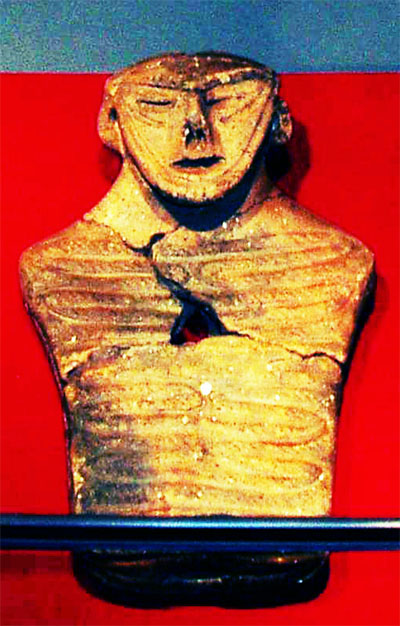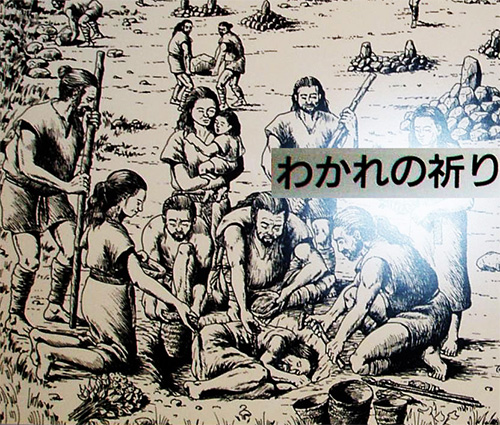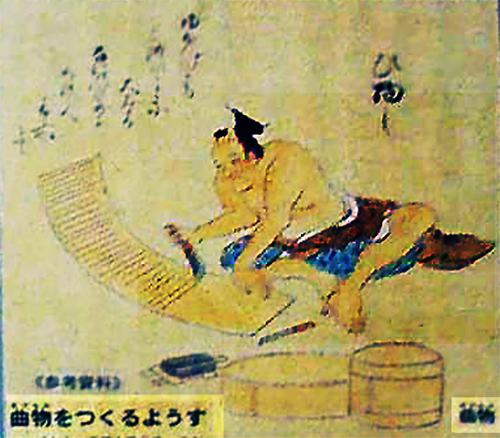

人間の死はその属する社会にとって、その家族にとって痛恨事であることは論を待たない。ただし、その社会段階によって、それを悼む方法と鎮魂の道行きには違いが生じる。
わたしたちは基本的には日本人社会という大枠のなかでその価値感世界で生きている。その社会の中には国家として統合されてきたあらゆる地域社会のそれが昇華されてきているのだろう。だから、旧石器由来の狩猟採集社会のそれも意識下の世界に実存していると想像できる。
死者の魂の表現として,多くが「石」に仮託されて鎮魂される習慣が多いというような意識下のカタチ、精神の進化過程の初源を探る、というようなアプローチがいるのだろう。これは石器時代という長い人類の精神史が反映しているとみなせるだろう。
土偶というものは、農耕以降の社会は比較的に「断絶感」をもってきている。歴史家の多数派意見としては、宗教以前の社会の「祈り」が外化した文化伝統とは言えるだろう。とくに北海道島で発見された上の土偶の表情、たたずまいからは独特の死者へのリスペクトを感じる。
本州以南の「日本」社会では死者の葬送はその身分階級による分化を表現するものになっていった。集団墓から権力者の独自の墳墓、古墳が造営されていって、さらにそれが同時にヤマト王権連合のシルシとしての「前方後円墳」という形象化にまで至っていた。それが行きすぎていったことと、中央集権国家の成立とが同時進行して、仏教の導入による寺院建築に繋がっていった。
しかし、北海道島ではごく一部を除いて(江別地域の古墳)古墳文化は広がらず、縄文由来の葬送形式が継続し、土偶も同様に継続していったとされている。土偶には死を悼む以上に、あらたな命、女性の妊娠・出産への社会の強い祈願が込められもした。生と死というふたつの側面が平行した。

しかしすでに見たように、上の職人仕事図に表現されるような生活文化の最先端様式は、活発な交易活動によって北海道の擦文社会にも流入していた。イラストは「曲げ物」と言われた「たらい」とかの日本社会の当時の「最先端」技術木製品容器。これらは擦文社会になくてはならない生活文化様式を構成し深く浸透していたとされる。その木製品の素材として樹種があきらかに北海道には自生しないものであること、そういう工芸文化がまったく擦文の社会には見られないことなどから日本社会との交易の結果であることは明白。
そうであるとしたら、葬送という人間社会の根幹をなすような精神文化様式についての交流というものはまったくなかったのだろうか、と不思議な気持ちになる。異性間での恋愛や混血というようなことも普通にあっただろうし・・・。
古代以来の北海道島社会の葬送形式として知られるのは周堤墓。これは地面に円形に竪穴を掘り、掘り上げた土を周囲に環状に積み上げることで大規模なドーナツ状の周堤を作り、その中に複数の墓を配置した大規模な集団墓とされている。
墓制と社会システム、その哲学には強い相関があることは自明。わたしたち現代人にもこういった墓制への心理のルーツのようなものがあり得るのだろうかと自問しています。
English version⬇
Religion and Funeral Service in Hunter-Gatherer Society: Exploration of Sapporo “Rubbun” Site-5
The death of a member of society is expressed in accordance with its importance, but on Hokkaido Island, mass grave sites are predominant. Furthermore, what is the meaning of the continued culture of clay figures? …
It is indisputable that the death of a human being is a painful event for the society to which he or she belongs and for his or her family. However, the way of mourning and the path of repose differ depending on the social stage of the society.
Basically, we live in a world of values within the framework of Japanese society. Within that society, we are sublimating the values of all the local communities that have been integrated into the nation-state. Therefore, we can imagine that the Paleolithic-derived hunter-gatherer society also exists in the world of consciousness.
We should take such an approach as to search for the origin of the evolutionary process of the spirit, which is a subconscious form of the souls of the dead, many of which have the custom of being reposed in “stone” as an expression of the souls of the dead. This approach may reflect the long spiritual history of mankind during the Stone Age.
Post-agricultural societies have had a comparative “sense of disconnection” with clay figurines. The majority opinion of historians is that they are a cultural tradition that is an outgrowth of the “prayers” of pre-religious societies. In particular, the expression and posture of the above clay figurine found on the island of Hokkaido shows a unique respect for the dead.
In “Japanese” society south of Honshu, the burial of the dead became an expression of the differentiation of status and class. From mass graves, the burial mounds of those in power were constructed, and this led to the figuration of “front-rear round tombs” as a silhouette of the Yamato royal union. This went too far, and the establishment of a centralized state coincided with the introduction of Buddhism, which led to the construction of temples.
However, with the exception of a small portion of Hokkaido Island (Kofun tumulus in the Ebetsu area), the Kofun culture did not spread, and the Jomon-derived funerary practices continued, as did the use of clay figurines. Clay figurines were not only a form of mourning for the dead, but also a form of prayer for new life, and for women’s pregnancy and childbirth. The two aspects of life and death were paralleled.
However, as we have already seen, the cutting-edge lifestyle culture represented in the craftsman’s work illustration above also flowed into Hokkaido’s abraded society through active trading activities. The illustration shows “cutting-edge” technological wooden vessels of Japanese society at the time, such as the “tub,” which was known as a “kenkemono” (curved object). These products were an indispensable part of the lifestyle and culture of the Abravaean society, and are said to have penetrated deeply into that society. The fact that the species of wood used as the material for these wooden products is clearly not native to Hokkaido, and the fact that such craft culture is not found in the Abravaean society at all, makes it clear that they were the result of trade with Japanese society.
If this is the case, one wonders if there was any exchange at all in terms of funerary rituals, a spiritual and cultural practice that is fundamental to human society. It is also likely that intersexual romance and mixed blood were common.
The funeral style known in Hokkaido Island society since ancient times is the shuutsutsumi tomb. This is considered to be a large-scale mass grave, in which a circular pit is dug into the ground and the dug-up earth is piled up in a ring around it to form a large doughnut-shaped peri-dike, within which multiple graves are placed.
It is obvious that there is a strong correlation between the tomb system, the social system, and its philosophy. I ask myself whether we modern people also have psychological roots in this kind of tomb system.
Posted on 12月 10th, 2023 by 三木 奎吾
Filed under: 日本社会・文化研究, 歴史探訪







コメントを投稿
「※誹謗中傷や、悪意のある書き込み、営利目的などのコメントを防ぐために、投稿された全てのコメントは一時的に保留されますのでご了承ください。」
You must be logged in to post a comment.